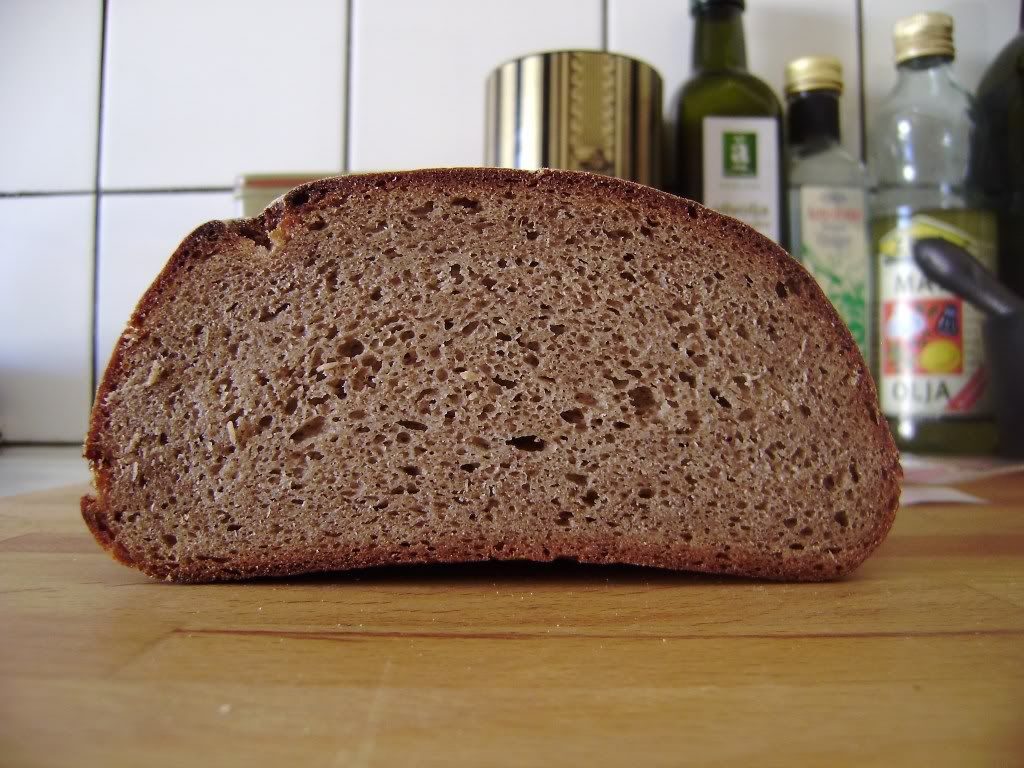Seeing as rye breads are all over this place nowdays I decided to share some loaves I have baked the last weeks. First up is the 80% rye with soaker from Bread. This bread is really great! I made two of these 850g breads and they lasted a week each, with some saved in the freezer for the next time I make the Horst bandel black pumpernickel.
This is how one of the loaves looked when ready for cutting. A little overfoured I have to admit..

I am really fond of the cracks that appear when you make properly proofed rye breads. When I cut the loaves open I found a much more open crumb than what I am used to when handling this kind of high percentage rye, to me the crumb looks more like a 60% rye than an 80%. This combined with a robust rye flavor made for great open face sandwiches with cream cheese and chives. Who whould say no to that?

I also baked some "american pumpernickel", I do not really know what classifies a bread as pumpernickel though. This loaf is a 40%rye made with finely ground rye flour with some ground up caraway and fennel added, the color is homemade caramel coloring. The tomato is a tomato..


- Kuret's Blog
- Log in or register to post comments
Regarding what makes a "pumpernickel:" My understanding is that the traditional German pumpernickel is a very dense sourdough rye bread made with coarsely ground whole rye flour (rye meal or pumpernickel flour). Its dark color is the product of a very long bake in a relatively cool oven. It is generally made as a pan loaf and, I think, the pan is usually if not always covered (pullman-type pan). I don't know if it always includes altus.
"American pumpernickel" seems defined as any bread that is made with some rye flour and is made almost black by the addition of a coloring agent which could be caramel coloring, coffee, chocolate, prunes or a combination of these.
"Jewish-American pumpernickel" is a sourdough rye made with coarsely ground rye. However, the rye flour may be only 30-40% of the total flour. It traditionally includes some altus. It does include one of the above coloring agents.
That's the best I've been able to figure out. Of course, the differences allow for endless discussions regarding what is "real" pumpernickel. These are entertaining the first time around. After that, I'd rather bake it than discuss it.
Nice tomato too. No crumb shot of the tomato?
David
Ok, so Im guessing the brown rye bread I made probably isn´t dark enough to be called american pumpernickel, I have howerver gotten very fond of darkening breads with caramel coloring both the color and taste are really ejoyable.
If anyone wonders the Horst bandel black pumpernickel is kind of an oddball pumpernickel seeing as it is really to light to be called a true pumpernickel but is still baked for a full night before unmolding. I find it more similar to products sold as Danish rye here in Sweden than what is sold under the name pumpernickel. At least that was how mine turned out the one time I have made it.
No crumb shot of the tomato, d'oh, but everyone has seen storebought tomatoes before right? It might be more interesting to see crumb shots of my bucket-raised roma tomatoes... maybe I should snap some.
And sometimes a cigar is just a cigar, too.
Paul
Is a Dominican cigar a real cigar?
David
Beautiful loaves! Your crumb shots make me hungry, Kuret. How do you determine that a rye dough is properly proofed? What did you use to dock the first loaf, and how deeply? Did you dock it just before baking? Did you bake it seam side up? Thank you.
It is hard to judge when a high percentage rye is proofed enough, especially as the window of opportunity for oven transfer is really short. However the signs I have seen are that the size has increased to slightly less than what you expect the finished loaf to be(this really demands practice with the same recipe over and over). Also I find that a properly proofed rye dough still feels kind of hard, meaning not springy or spongy, but on the verge of becoming spongy.
However, I have only been baking regularly for circa 2 years and 25% tops of the loaves I have made are with more than 50% rye flour so more experience will probably yield a better explanation of how the dough is suposed to feel.
Isnt feel always hard to express in words?
About docking, I used a chopstick roughly 6mm diameter slightly smaller than 1/4inch. I docked the bread before loadng them into the oven having previously been proofing in brotforms. I did not bake the bread seam side up, I have never baked a rye that way as I feel that the dough wants all the stability thats possible to ensure taller loaves instead of flatter ones.
Beautiful loaves and the crumb looks gorgeous!
Sylvia
Beautiful loaves!
Mini